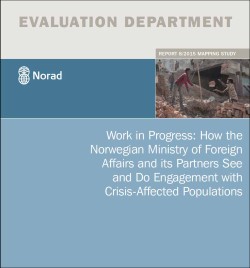Work in Progress: How the Norwegian Ministry of Foreign Affairs and its Partners See and Do Engagement with Crisis-Affected Populations
Om publikasjonen
- Utgitt: november 2015
- Serie: Evalueringsrapporter
- Type: Evalueringer
- Utført av: Nordic Consulting Group AS (NCG)
- Bestilt av: Norad
- Land: --
- Tema: --
- Antall sider: 67
- Serienummer: 8/2015
- ISBN: 978-82-7548-818-1
- ISSN: --

Hvordan inkludere de kriserammede i det humanitære arbeidet?
Alle humanitære aktører er enige i at målgruppen for humanitært arbeid – de kriserammede – bør aktivt inkluderes i arbeidet for best mulig humanitær innsats. Men hvem skal inkluderes, hvordan, og når: ved planlegging, gjennomføring og/eller rapportering og evaluering? Og hvorfor skal de inkluderes – er det først og fremst fordi den humanitære innsatsen da blir mer effektiv, eller på grunnlag av et normativt prinsipp om at de har rett til å bli tatt med på råd i arbeid som angår dem? Denne gjennomgangen viser at humanitære aktører har økende oppmerksomhet på slike sider ved det humanitære arbeidet, men at det kan være stor forskjell på vedtatt policy og praksis. Mye gjenstår når det gjelder å finne gode tilnærminger og metoder for å involvere de kriserammede.
How to engage crisis affected people in humanitarian assistance?
There is general agreement among humanitarian actors that crisis affected people should be engaged in humanitarian assistance. Nonetheless, questions remain as to how to engage, with whom, and when – in planning and design, implementation, reporting and evaluation. There are also questions about the main purpose for engagement, as engagement can be justified both in normative terms – as crisis affected people have the right to be involved in decisions and activities concerning them, and in pragmatic terms – as it is expected to improve quality and effectiveness of humanitarian assistance.
The study maps how engagement with crisis-affected populations has been understood, implemented, and thought of by humanitarian agencies channeling most of Norwegian humanitarian assistance. It demonstrates that the issue is increasingly on the agenda among all agencies, but that rationales and policies differ between agencies, and that there are many obstacles involved when going from policy to practice.
